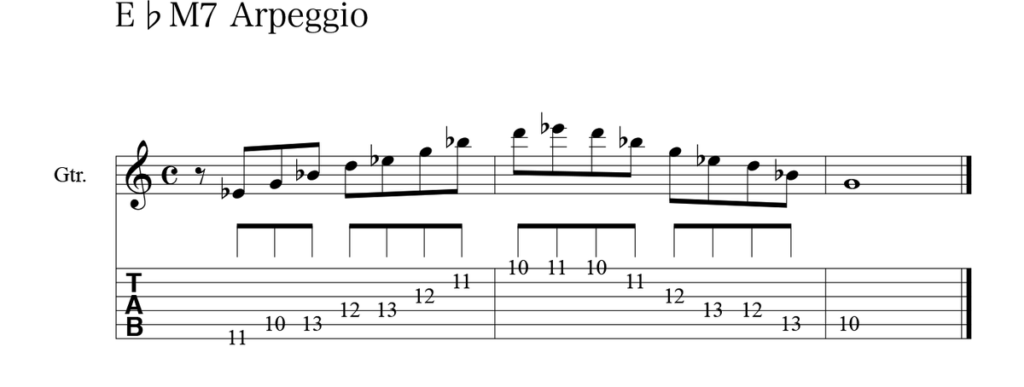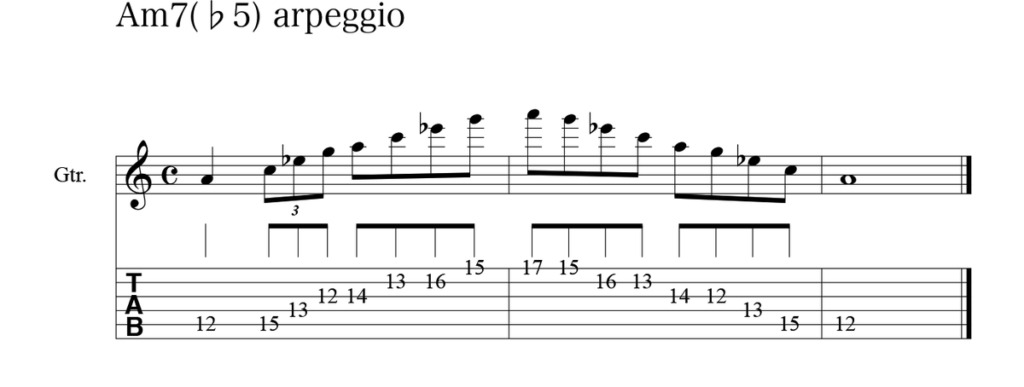Now I will show you how to effectively use a note that is outside a chord or a scale.
Outside phrasing roughly includes the following three concepts:
- making a phrase with a note that is not a chord tone
- shifting a tonality
- superimposing completely different chord progression” (my personal favorite)
Contents
First step of outside phrasing
Pentatonic & Dorian
John and Mike are playing the guitar together. Mike is playing the melody while John is playing Cm7.
First, Mike played the melody only using C, E♭, G, and B♭ which are four notes constituting It’s fine, but maybe something easier to read like “from Cm7”
Mike found just this bland, so he added F (fourth note in Cm7) in the melody.
So, Mike is now playing C minor pentatonic scale (C・E♭・F・G・B♭).
With the F note, the melody got very melodic, and then Mike further added 9th and 6th (D and A)To further spice things up.
Now Mike is playing C Dorian Scale (C・D・E♭・F・G・A・B♭), which is a scale in Key of Bb starting from the second note in B♭.
Here, Mike is still playing “inside” the chord.
Just remember that Mike gradually added the tension notes to make the melody more interesting.
Second step of outside phrasing
Shifting tonality
After playing the melody with C Dorian Scale, Mike thought that “there must be more scales I can use in Cm7.
C Phrygian Scale, C Aeolian Scale, and C Locrian Scale should also be suitable, as all these scales have Eb that is a key chord tone of Cm!”
So, Mike immediately tried his idea. He used C Dorian Scale for one bar, C Phrygian Scale for the next bar, C Aeolian Scale for the next, and then C Locrian Scale.
Mike was right! The scales went perfectly well with Cm7.
However, his humble partner, who has been playing the chord all this time, felt something was a little off.
This is because Mike was shifting the tonality from one bar to another.

*Mike first played in the Key of Bb, and then played C Phrygian Scale, so the key shifted to Key of Ab.
Then, Mike used C Aeolian Scale so the key changed to the Key of Eb, and used C Locrian Scale so the key changed to the Key of Db.
As you can see, the melody transposed to the different key by changing the scale from C Dorian to C Phrygian.
Now let’s check the difference among the four scales.
C Dorian
「C・D・E♭・F・G・A・B♭」
C Phrygian
「C・D♭・E♭・F・G・A♭・B♭」
C Aeolian Scale
「C・D・E♭・F・G・A♭・B♭」
C Locrian Scale
「C・D♭・E♭・F・G♭・A♭・B♭」
C Phrygian has the second and the sixth flatted from C Dorian.
C Aeolian has the sixth flatted.
C Locrian has the second, the fifth, and the sixth flatted.
As shown above, C Locrian has the largest number of notes different from C Dorian, while C Aeolian has the smallest number of notes different from C Dorian.
Thus, among the scales, the most outside sound can be obtained with C Locrian, and the most inside sound can be obtained with C Aeolian
Here, the description is given with a case where Cm7 is in the Key of Bb as an example.
You have to understand the inside to understand the outside.
Final step of outside phrasing
Arpeggio
Mike thought of another approach to obtain inside phrase, arpeggio.
Mike used arpeggios of E♭M7 as ⅣM7 in B♭Major Scale, and Am7(♭5) as Ⅶm7(♭5) in B♭Major Scale, and both went perfectly well with the chord.
E♭M7 Arpeggio「E♭・G・B♭・D」
The arpeggio of E♭M7 is constituted of ♭3rd, 5th,♭7th, 9th of Cm7, and thus the Cm9 sound is obtained.

Am7(♭5) Arpeggio「A・C・E♭・G」
The arpeggio of Am7(♭5) is constituted of 6th, Root,♭3rd, 5th, and thus Cm6 sound is obtained.
Through the enlightenments, Mike has become capable of enjoying inside and outside phrases with various arpeggios and scales. The End.

Let’s once again check the chord tones of Cm7, “C・E♭・G・B♭」/「 R,♭3, 5,♭7”.
Now let’s add the tension notes “D・F・A/9th, 4th, 6th” to get C Dorian “C・D・E♭・F・G・A・B♭”.
This is all you need to know to understand the inside sound, but question remains, “Who decided that Cm7 is Ⅱm7 (C Dorian)?”
C Dorian is in the Key of Bb, but if “Cm7” is the only information you have, you cannot figure out what key it is in.
If the key has been decided by the players before the tune is played, or there is a score and the melody made of C Dorian is written, the key is Bb, but if nothing has been decided, the one who plays the melody decides the key .
If he plays C Phrygian, the key is A♭ and thus “C・D♭・E♭・F・G・A♭・B♭” are the inside notes, and all the other notes are outside notes.
Hopefully you understood the concept of the inside sound.
In the next chapter, I will show you a simple, yet bold, practical approach through further description of “outside sound” in Cm7.







